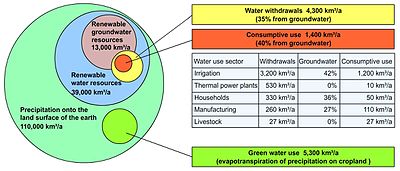**Natural Water Sources:**
– Surface water replenished by precipitation and impacted by human activities.
– Groundwater constitutes about 30% of all readily available freshwater globally.
– Rivers transport water downstream and have unseen flows.
– Brazil, Russia, and Canada have significant fresh water supplies.
– Glacier runoff in the Himalayas is crucial for over a billion people’s livelihoods.
**Artificial Water Sources and Treatment:**
– Artificial sources include treated wastewater, atmospheric water generators, and desalinated seawater.
– Water reclamation processes municipal or industrial wastewater into reusable water.
– Technologies like ozonation and ultrafiltration are used for water treatment.
– Desalination is used to provide fresh water but is costly due to energy consumption.
– Water reuse practices aim to reduce pressure on natural water bodies.
**Water Use in Different Sectors:**
– Agriculture heavily relies on irrigation methods and water sources like groundwater and surface water.
– Industries use a significant amount of water, especially in dams and power plants.
– Domestic water use accounts for 8% globally, with basic requirements around 50 liters per person per day.
– Environmental water usage is increasing, impacting water availability for other users.
– Recreational water use is tied to various activities and may reduce availability for other users.
**Challenges and Management of Water Resources:**
– Threats include water scarcity, pollution, conflict, and climate change.
– Water resource management involves planning, developing, and managing water resources.
– Sustainable water management focuses on optimizing water use and minimizing environmental impact.
– Integrated Water Resources Management promotes coordinated development and management of water resources.
– Managing water in urban settings aims to change the impact of urban development on the natural water cycle.
**Global Water Distribution and Conservation:**
– Groundwater is the largest source of fresh, unfrozen water on Earth.
– Only about 1% of the world’s water supply is available for human use.
– Water scarcity affects over 2 billion people globally, with worsening projections.
– Innovations in atmospheric water generation aim to address global water security challenges.
– Potable water reuse involves treating wastewater for high-quality drinking water production.
Water resources are natural resources of water that are potentially useful for humans, for example as a source of drinking water supply or irrigation water. 97% of the water on Earth is salt water and only three percent is fresh water; slightly over two-thirds of this is frozen in glaciers and polar ice caps. The remaining unfrozen freshwater is found mainly as groundwater, with only a small fraction present above ground or in the air. Natural sources of fresh water include surface water, under river flow, groundwater and frozen water. Artificial sources of fresh water can include treated wastewater (wastewater reuse) and desalinated seawater. Human uses of water resources include agricultural, industrial, household, recreational and environmental activities.

Water resources are under threat from water scarcity, water pollution, water conflict and climate change. Fresh water is a renewable resource, yet the world's supply of groundwater is steadily decreasing, with depletion occurring most prominently in Asia, South America and North America, although it is still unclear how much natural renewal balances this usage, and whether ecosystems are threatened.
